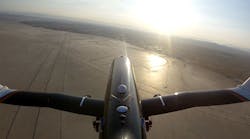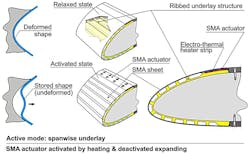The NASA project Spanwise Adaptive Wing (SAW) has been around for a few years. The idea is to control outboard wing tip positions as much as 75 deg. to meet optimal demands in landing and takeoff, as well as flight. Folding wings in has been studied on aircraft in the past, including the North American XB-70 Valkyrie in the 1960s. Yet, to fold wings in flight requires heavy and bulky conventional motors and hydraulic systems, which are burdensome to the aircraft.
The SAW concept allows for aeronautical engineers to create airplanes that have smaller vertical tails by installing adjustable tips on the aircraft’s wings. These tips can be positioned upward or downward to assist in takeoff, flight, and landing. The SAW project took another step forward in creating a successful application case by adopting a new lightweight material known as shape memory alloy (SMA).
The subscale testbed PTERA flies over NASA Armstrong Flight Research Center in California with the outer portions of its wings folded 70 deg. upward. The aircraft took off with its wings at 0 deg. deflection, keeping them level during takeoff. The wings were folded during the flight using a thermally-triggered shape memory alloy, developed at Glenn Research Center and integrated into an actuator at Boeing Research & Technology. This technology would alloy pilots to fold their aircraft’s wings to different angles to adapt to multiple flight conditions for aerodynamic benefit. (Credit: Area-I Inc)
SAW is a joint effort between Armstrong, NASA’s Glenn Research Center in Cleveland (GRC); Langley Research Center in Virginia; Boeing Research & Technology in St. Louis and Seattle; and Area-I Inc. in Kennesaw, Ga. The SAW researchers intend to use the shape memory alloy to obtain several aerodynamic benefits while they fold wings. The alloy will be built into an actuator on the aircraft. The actuator is vital to the moving parts on the airplane. It can fold the outer portion of an aircraft’s wings in flight without putting strain on the hydraulic system. This help the system weight up to 80% less than traditional systems.
Shape memory alloys have two distinct crystal structures or phases. Temperature and internal stresses determine the phase of the SMA and its super-elasticity. Martensite exists at lower temperatures; austenite exists at higher temperatures. At low temperatures the SMA is in martensite form and can easily be deformed into any shape. As the alloy is heated, it transforms from martensite to austenite.
In the austenite phase, the memory metal retains its previous from before it was deformed. Memory alloys also have great rates of super-elasticity. Austenite is not stable at room temperature, and because systems always seek lower energy states, the austenite will change back to the martensite phase—and to do this, the arm must bend back.
A common example of an SMA are eyeglass frames that exist in the martensite phase. Bending the arms in half at room temperature introduces a phase change at the bend to austenite. The most common SMA is NiTinol, which consists of equal parts nickel and titanium.
The shape memory alloy used by NASA for their test is triggered by temperature. It works by using thermal memory in a tube to move and function as an actuator. When the alloy is heated it activates a twisting motion in the tubes, moving the wing’s outer portion up or down. The GRC developed the initial alloy material, working with Boeing to employ the alloy with an actuator in flight.
Shape memory alloy has several possible aerospace applications. Along with being used as a method for wing folding during flight, it has also been proposed to be used for deicing and anti-icing. Its shape changing properties can be used for ice removal when required. (Credit: “An Overview of the Deicing and Antiicing Technologies with prospects for the Future,” by Zdobyslaw Goraj)
NASA used the remotely-controlled flight testbed Prototype Technology-Evaluation Research Aircraft (PTERA) to test the SMA. PTERA was designed and built by Area-I, which helped design and integrate a shape memory alloy-actuated, wing-folding mechanism for the aircraft. The PTERA is a small-scale UAV that features extensive flight instrumentation for data gathering and can accommodate newly-designed wings for testing.
The SAW test flights were conducted over two days. The PTERA took off with its wings at a level, zero-degree deflection, and during flight maneuvers, the onboard controllers heated and cooled the SAW actuators. The actuators folded the wing panels to different angles between 0 and 70 deg. For the first two flights, the wing tips were rigged to fold downward. Later flights featured rearranging the aircraft hardware to fold the wings in a 70-deg. upward deflection. Each wing-folding maneuver was achieved within three minutes.
The aerodynamic benefit of having foldable wings varies between subsonic and supersonic aircraft. For subsonic aircraft, such as drones or commercial airlines, the potential aerodynamic benefit of folding the wings includes increased controllability, resulting in a reduced dependency on heavier parts of the aircraft like the tail rudder. This creates a more fuel-efficient aircraft and allows long-winged aircraft to taxi in airports. The other added benefit is that pilots can take advantage of different flight conditions, including wind gusts.
The Spanwise Adaptive Wing concept seeks to enhance aircraft performance through allowing the outboard portions of wings to adapt, or fold, according to different flight condition demands. NASA engineers believe this could create lateral-directional stability and reduce drag. (Credit: NASA)
With supersonic aircrafts, one of the most significant potential benefits is to achieve faster than the speed of sound flight. “There’s a lot of benefit in folding the wing tips downward to sort of ‘ride the wave’ in supersonic flight, including reduced drag,” said SAW Principal Investigator Matt Moholt. “This may result in more efficient supersonic flight.
“Through this effort, we may be able to enable this element to the next generation of supersonic flight,” he continued, “to not only reduce drag but also increase performance, as you transition from subsonic to supersonic speeds. This is made possible using shape memory alloy.”




